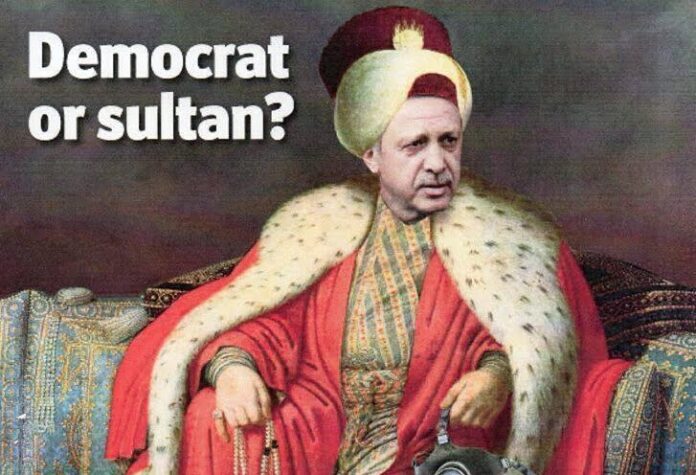(THIS ARTICLE IS MACHINE TRANSLATED by Google from Norwegian)
May 1453: Sultan Mehmet 2, to be named the Conqueror, enters the main gate of the Byzantine Hagia Sofia Cathedral in Constantinople. There he falls into prayer and converts the cathedral into a mosque.
July 2020: Turkish President Recep Tayyip Erdoğan goes through the same gate and performs a Muslim prayer ritual. 86 years after the founder of modern Turkey, Mustafa Kemal Atatürk, turned the world-famous building into a museum, it becomes a mosque again.
Mehmet the Conqueror hid icons, large paintings and gold mosaics and replaced them with calligraphy with religious texts. Erdoğan has hidden depictions of Jesus, Mary and the disciples with long curtains to be pushed away when there is no prayer time. Because then the building will be a museum.
Mehmet Conquer
Neo-Ottomanism has become a cultural, political and ideological term in recent years. President Erdoğan and many other Turks dream back to the Ottoman era, when the Turks led a world empire.
Neo-Ottomanism has become a cultural, political and ideological term in recent years.
There have been more TV series about Mehmet the Conqueror in recent years, and they have become Erdoğan's favourites. With the president in the front seat, Ottoman history has had a resurgence in Turkey. In a number of public buildings and in the offices of the ruling AKP party hang pictures of former sultans and maps showing the extent of the Ottoman Empire at its greatest. In election campaigns, AKP candidates have often allowed themselves to be pictured in Ottoman clothing, and Erdoğan himself likes to use Ottoman symbols.
In Istanbul, the multinational hamburger chain Burger King has its own janissary menu.
The Ottoman Empire existed for over 600 years, and this world empire stretched at its greatest from Iran to Algeria, and from the Balkans to Yemen. A total of 36 sultans, some very capable, others a little more drunk, ruled the kingdom through conquests, prosperity, economic downturns and military defeats.
Erdoğan sits in a large palace, but without a harem and concubines.
As we saw at the outset, Erdoğan feels a strong connection to Mehmet the Conqueror. However, there is one major difference between the two. While Mehmet wanted to conquer new land, Erdoğan has not territorial but ideological, political, cultural, military and economic ambitions. He wants to build up Turkey as a great power with increased influence in the former Muslim Ottoman areas.
Erdoğan sits in a large palace, but without a harem and concubines. The president appears as a devout Muslim, but is also a devout or devout Islamist. All the sultans of the Ottoman Empire were Muslims, but their relationship with the religion was often mixed.
Similarities and differences
Erdoğan leads a state where around 98 percent are muslimis. The Ottoman sultans ruled over Muslims, Christians and Jews; in some areas the Christians could be in the majority. The three faiths had their own millets (faith-defined people group), where there was self-government when it came to religion and family law. The Muslims had the gulf and both ends, but the system worked until nationalism swept over Greece and the Balkans in the early 1800s.
When countries such as Greece, Serbia, Bulgaria and Bosnia-Herzegovina broke away from The Ottoman Empire during the said century, the Ottoman sultans gained even more enemies in Europe than they had previously. But there is one significant difference between them and Erdoğan. While Erdoğan is largely unfriended by most of Europe, var sultanone far more pragmatic. Already Osman 1 allied himself with Byzantine Christian forces during his conquests. Throughout the Ottoman period, the sultans not only had Christian soldiers and mercenaries, they also had a good relationship with individual European countries. The Ottoman Empire and France had good relations for 250 years, from 1536 until Napoleon invaded Egypt in 1798. Relations with England, later Great Britain, were good at times. The same applied to the relationship with Venice and other countries and city-states. The Sultans' mantra was divide and rule, and they succeeded.
Turkish Muslim Democrat
Recep Tayyip Erdoğan has made himself unfriended Europe, or should we say the opposite: that Europe has made itself unfriendly to him?
It looked good when Erdoğan became prime minister in 2003. Negotiations with the EU were underway, and the Turkish prime minister appeared as a kind of Turkish Muslim democrat. On 7 May 2004, Turkey abolished the death penalty, and the EU negotiations seemed relatively promising. But a week earlier Cyprus had joined the EU and the Greek Cypriots, who had seen the northern part of their country occupied by Turkey in 1974, were unwilling to budge. The negotiations stalled, and both EU leaders and Erdoğan toughened their demands. When Turkey became involved in the Arab Spring in 2011, first on the side of the Muslim Brotherhood in Egypt, then as a supporter of several Islamist groups in the civil war in Syria, relations with Europe cooled further, while Erdoğan came into conflict with the United States.
A diplomatic source said some time ago that President Erdoğan has become increasingly angry after the West has opposed him.
Erdoğan's dynasty
All the sultans of the Ottoman era came from the same originator, Osman 1. What about Erdoğan's dynasty?
Erdoğan's sons and sons-in-law are prominent businessmen with close ties to the regime. The son-in-law Selçuk Bayraktar is the head of Turkey's leading factory complex for military drones.
Erdoğan can currently remain president until 2029, but he could do like Vladimir Putin and stay in power even longer.
Then we will see who will be his heir.


